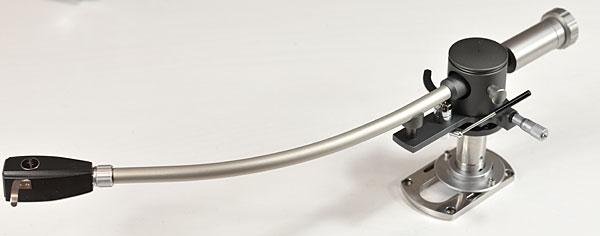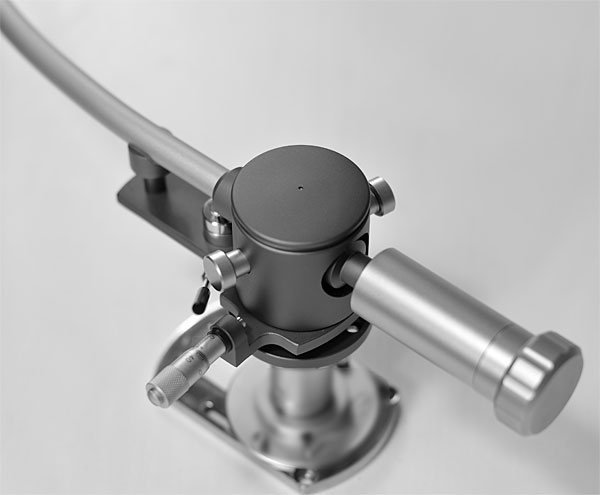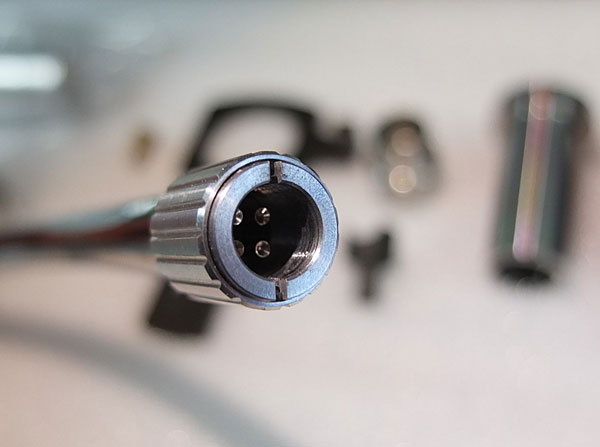| Columns Retired Columns & Blogs |
... an SME M2-12R or a Jelco SA-750L?

Had my self-training not been so, I might have jumped out of my skin—literally, like those unfortunate audiophiles whose actual jaws have taken up permanent residence on actual floors—while waiting for the arrival, also via the US Postal Service, of a new tonearm from the Netherlands: the GrooveMaster II, made by Audio-Creative, a manufacturer-distributor-retailer (footnote 1). I was anxious because the GrooveMaster II, like the Swissonor TA10 I wrote about in the December 2017 "Listening," is described by Audio-Creative and their US dealer, Mockingbird Distribution, as being an especially good choice for use with the Thorens TD 124 turntable. That sort of thing always catches my eye.
The GrooveMaster II is described on the Audio-Creative website as having been inspired by the classic transcription tonearms used in broadcasting throughout the 1950s and '60s. It's a 12" pivoting arm of intentionally high mass, the latter characteristic all but guaranteeing a good match with such low-compliance devices as the Denon DL-103 cartridge and various of Ortofon's SPU series of pickup heads: things I love the way the nine-year-old me loved comic books and anoles.

Engineering circles
There are a few different ways to engineer the desired degree of headshell offset into the armtube of a pivoting tonearm, and Audio-Creative has chosen the relatively unusual approach of curving their armtube like a banana, as opposed to making it S-shaped, or J-shaped, or straight with an abrupt angle at the cartridge end. In this regard it reveals the influence of the classic EMT 997 arm, introduced in the early 1970s and still being made today. But the GrooveMaster II lacks the EMT's dynamically applied downforce, and also differs in that the centers of its vertical and horizontal pivots are coincident, as in most pivoting arms. Interestingly, the center of the EMT 997's vertical pivot is a few millimeters to one side of the center of its horizontal pivot, the latter point defining the arm's effective length. Also unlike the EMT, whose antiskating mechanism, comprising a thread and a falling weight, is more or less an afterthought—indeed, one seldom sees 997s with that mechanism in use—the GrooveMaster has a built-in magnetic-bias device. Both arms have offset vertical bearings that match the offset angle of the headshell, and neither comes with a headshell.
The GrooveMaster II has the following specs: a spindle-to-pivot distance of 304.75mm, an offset angle of 17.11°, overhang of 12.82mm, an effective length of 317.57mm, and an effective mass of 22gm, the last considerably higher than average.
The price for a basic GrooveMaster II is €1175. Available options include: an arm-mount collet built into a sliding track—which, like similar products from SME, offers the user the ability to adjust the spindle-to-pivot mounting distance, and thus overhang (€175); a titanium armtube (€220); and pure-silver tonearm wiring made by Cardas (€95). Audio-Creative supplied me with the sliding base, prefastened to a wooden TD 124 armboard, itself sized for a 12" arm, as well as with not one but two GrooveMaster IIs: one each with the stock aluminum and titanium armtubes.
I began with the stock, aluminum-tubed GrooveMaster II. Apart from simply lowering the arm pillar into the base, little assembly was required, most of it having to do with the GrooveMaster's system of counterweights. Supplied with the arm is a steel counterweight a little over 1.5" long: one end slips over a stub at the rear end of the arm—there's a setscrew for locking the weight into place, once the correct downforce has been dialed in—and the other end is fitted with a machine screw, to which is fastened a ridged steel endcap of slightly larger diameter than the counterweight. Because the mass represented by these two elements won't suit every possible combination of cartridge and headshell, the arm also comes with two spacer weights—one about 0.5" long, the other a hair over 0.25"—to fit between the main weight and endcap. But each different combination—main weight only, main weight with short spacer, main weight with long spacer—requires a different-length screw to secure the endcap; these, too, are provided. (A long enough machine screw for use with the main and both auxiliary weights isn't supplied but seems theoretically possible.) The arm also comes with an aluminum main weight, for use with lighter-than-average cartridges. Swapping out weights and screws to achieve the right downforce with a variety of pickups is a bit involved, but I don't think that will inconvenience a great many users. Outside of audio reviewers.
I began my listening with Ortofon's bargain-priced SPU #1S pickup head ($599), which I played with a downforce of 4gm; that required the use of the main steel counterweight plus the smaller of the two auxiliary weights. I found it necessary to set the height-adjustable GrooveMaster II in its lowest position—ie, with its bearing housing as near as possible to the tonearm's mounting base. The TD 124 is unusual in that its platter rides quite low with respect to the turntable's chassis in general and its armboard in particular—and, if memory serves, there are one or two tonearms out there that, though suitable for the Thorens in every other regard, can't be set low enough to track records on the TD 124's platter without too steep a vertical tracking angle (VTA). The GrooveMaster seemed better than average in this regard—but still, there were times when I wished its height could be set even lower.

A stand-up arm
As I write this, I'm listening to Sir John Barbirolli's 1968 recording, with the New Philharmonia Orchestra, of Mahler's Symphony 6; my pressing isn't the EMI original, but a UK reissue (Classics for Pleasure CFP 41 4424 3), and it sounds awfully good. Recorded in Kingsway Hall, Barbirolli's interpretation, with its notoriously heavy, broadly paced introduction (and omission of a first-movement repeat), was the key to my getting this symphony, and so remains a particularly beloved record. (The first time I played it in my new listening room marked the transition from uncertainty about to satisfaction with that space.)
With the combination of GrooveMaster II tonearm and SPU #1S, this LP was sonically magnificent and emotionally powerful. In the opening march, the sense of the string players digging in to the music, conveyed through tone, texture, and sheer forcefulness, was put across perfectly—no other word for it. And the delicate beauty of the brief, chorale-like section in A, carried by the woodwinds and plucked strings, was conveyed with tremendous sonic color and musical feeling. (That Barbirolli's wife was an oboist may have contributed to the seeming reverence he brought to this passage.) And the GrooveMaster-SPU combination remained poised in the many forte passages, including the hammer blows, also notorious, in the Finale. To hear this arm and cartridge play this record was to think, Who needs anything more?

... an SME M2-12R or a Jelco SA-750L?

I loved the Sumiko MMT which is actually a Jelco.
This reviewed Arm looks like it has more adjustability and a far higher price, phew farrrrrrrrrrrrrr higher.
Having Records, as a hobby, is getting super expensive, especially considering that Chad Kassem's stuff is released digitally.
Tony in Michigan

Art,
I liked the GrooveMaster report. I have ordered one, even though I have a couple of Schicks.
In the same vein, you might consider a report on the Border Patrol DAC SE. Its a DAC that brings digital closer to vinyl. My wife who typically says "they all sound good", when hearing it said "that sounds like vinyl".

Art,
Has anything supplanted your EMT arm as "the" tonearm for the TD-124? I'm thinking of getting another TD-124, this time a full Schopper restoration. I'm torn between an EMT and the TA10, or does the Groovemaster offer just as much for considerably less?
Thank you!

Wonder how the GrooveMaster II would work with a Kleos and AT33Sa? Building a new plinth for my DP-80 TT and looks to be a worthy competitor to the SME M2-12R.